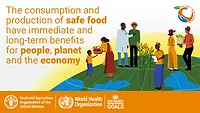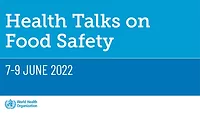WHO Adopts New Global Strategy for Food Safety

On May 27, 2022, at the 75th Session of the World Health Assembly, World Health Organization (WHO) Member States approved the new WHO Global Strategy for Food Safety 2022–2030 (GSFS). The strategy addresses current and emerging food safety challenges, takes into consideration new technologies, and includes innovative approaches for strengthening food safety systems. The strategy provides guidance for Member States in their efforts to strengthen their national food safety systems and promote regional and global cooperation.
Member States requested an update to GSFS at the 73rd Session of the World Health Assembly in 2020, noting that the food safety systems of many Member States are facing difficulties and require significant improvements in several areas, such as: regulatory infrastructure, enforcement, surveillance, inspection, laboratory capacity and capability, coordination mechanisms, emergency response, and food safety education and training. Member States also cited the need to integrate food safety into national and regional policies on health, agriculture, trade, environment, and development, and urged that a “One Health” approach should be applied to food safety efforts.
According to WHO, an estimated 1 in 10 people (600 million) will fall ill from over 200 diseases caused by unsafe food each year. Annually, these illnesses result in 33 million disability-adjusted life years and 420,000 premature deaths. The ramifications of unsafe food disproportionately affect vulnerable communities, such as infants and children, the elderly, immunocompromised people, and low- and middle-income countries.
WHO also stressed the urgency of addressing antimicrobial-resistant pathogens in the food system, estimating that antimicrobial resistance (AMR) will cost 10 million lives and $100 trillion dollars by 2050 if no proactive solutions are taken. A “One Health” approach to food safety not only helps mitigate the public health crisis that is AMR, but can also contribute to the achievement of the United Nations’ Sustainable Development Goals, of which food safety is a factor.
The recently adopted GSFS reflects Member States’ concerns, as well as feedback received through a comprehensive consultation process. The updated strategy outlines five interlinked and mutually supportive strategic priorities:
- Strengthening national food controls systems by 1) establishing a modern, harmonized, and evidence-based framework of food legislation; 2) establishing an institutional framework to coordinate the work of different authorities that manage national food control systems; 3) developing and implementing fit-for-purpose standards and guidelines; 4) strengthening compliance, verification, and enforcement; 5) strengthening food monitoring and surveillance systems; and 6) establishing food safety incident and emergency response systems.
- Identifying and responding to food safety challenges that arise with the evolution of food systems by 1) identifying and evaluating food safety impacts that are arising from global changes and transformations in food systems and the movement of food, and 2) adapting risk management options to emerging foodborne risks that are brought about by transformation and changes in global food systems and the movement of food.
- Increasing the use of scientific evidence and risk assessments in decision-making by 1) gathering information from and beyond food chains to make informed risk management decisions; 2) sourcing food safety information and risk analysis experiences from international communities to strengthen risk management decisions and technical capacity; and 3) making consistent and transparent risk management decisions when establishing food control measures.
- Strengthening stakeholder engagement and risk communication by 1) establishing platforms for consultation on the national food safety agenda; 2) assessing the pertinence of using non-regulatory systems for enhancing food safety across the food chain; 3) establishing frameworks for sharing compliance verification with food safety regulatory requirements; 4) facilitating communication, capacity-building, and engagement with food business operators and fostering a food safety culture; and 5) facilitating communication, education, and engagement with consumers.
- Promoting food safety as an essential component of trade by 1) strengthening food control systems and capacity development in regulatory systems for the domestic market; 2) strengthening interaction between national agencies that are responsible for domestic food safety and those facilitating international fair trade; 3) ensuring that national food safety systems are aligned with Codex Alimentarius standards to protect public health and facilitate trade; and 4) strengthening engagements of national competent authorities with international agencies and networks that establish standards and guidelines for food.
GSFS also asserts that, in addition to having critical infrastructure and components of food control systems in place, Member States must adopt four important characteristics for their food safety systems to become more effective. WHO suggests that Member States’ food safety systems should be forward-looking, evidence-based, people-centered, and cost-effective. GSFS also outlines a four-step strategy for Member States to develop, update, and implement their national food safety strategies, which includes: 1) conduct a situation analysis, 2) develop a national strategy and action plan on food safety, 3) implement the national strategy and action plan, and 4) conduct regular reviews of the implementation and action plan, and adjust the strategy as appropriate.
In the GSFS, WHO establishes its role in realizing the goals of the strategy. WHO commits to reducing the burden of foodborne illness by assisting Member States through advocacy, synthesis and analysis of information, generating guidance, enhancing technical cooperation and capacity, and building global partnerships.
Looking for quick answers on food safety topics?
Try Ask FSM, our new smart AI search tool.
Ask FSM →









